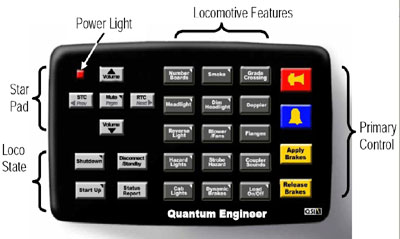The Quantum Engineer controller is an "add on" unit produced by QSI to control sounds in their QSI Sound Decoders for people who want to run pure DC on their layouts. The unit connects between your standard power pack and the track and gets its power from the power pack. All keys are labeled with the function they control. There are 28 keys on the unit and the sounds are different depending whether the locomotive is moving or stopped, diesel or steam. The keys that have a triangle in the upper right corner turn on with one click and turn off with two clicks.
The Quantum Engineer will control the following functions: horn, bell, apply air brakes, release air brakes, loco shut down, loco start up, standby idle, flange squeal, squealing of brakes, Doppler shift, coupler lift bar, coupler opening sounds, coupler crash, load on/off, heavy load on/off, volume control in run mode, regulated (RTC0 and standard (STC) throttle, grade crossing signal, smoke on/off, headlight on/off and dim, reverse light on/off, number boards on/off, hazard lights on/off and strobe, cab lights on/off, blower or fan on/off, dynamic brakes on/off, motor disconnect, mute, verbal speedometer readout, locomotive status, easy quantum programming, previous and next program stepping.
The engine sounds will start working at around 4 volts, with the engine starting to move at around 8 volts. This of course will vary with manufacturer, with my test loco being an Aristo FA locomotive. There are two settings for throttle response: STC for Standard which is perfect for switching because of quick response. RTC or Regulated for momentum and main line running. Sound volume can be changed at any time using the volume keys.
The Brake Set and Brake Release keys do several things. Push the Set key and the loco will coast to a stop. Hold it down and you will hear brake squeal as you come to a stop. Once stopped, a double click on the Release key will start the loco moving again, and it will eventually come back to its original speed. The Load key lets the locomotive produce a laboring sound when starting and a drifting sound when slowing down.
As I previously noted in an earlier article, the unit can only handle a low amperage draw (2.5) which means one loco per track without the optional Booster. It does, however, give you DCC sound functions with a pure DC control system. This allows you to take advantage of the many sounds the QSI Sound Decoder can produce, other than just the bell or whistle/horn which can be controlled by a reversing operation on the handheld Aristo TE.


